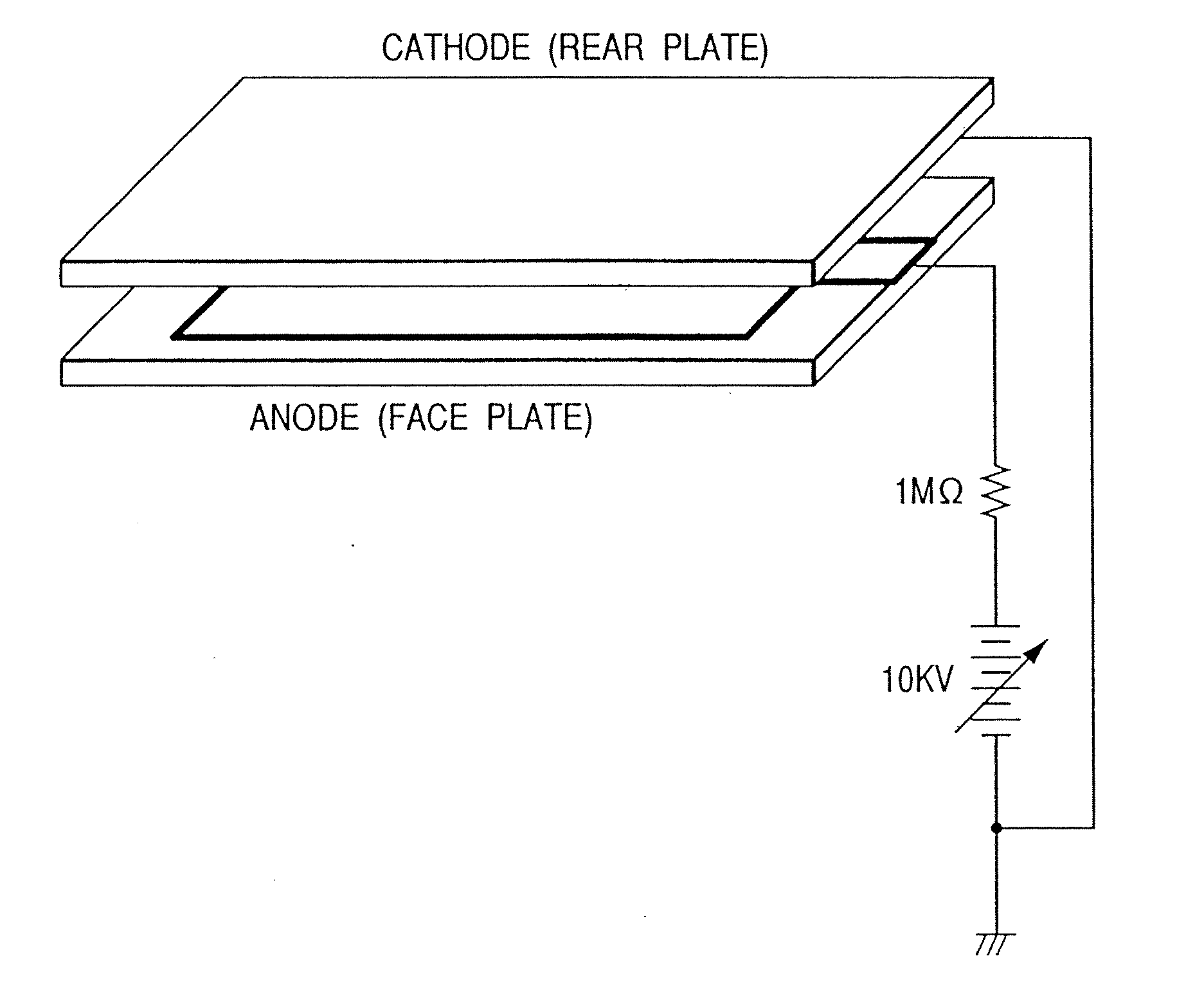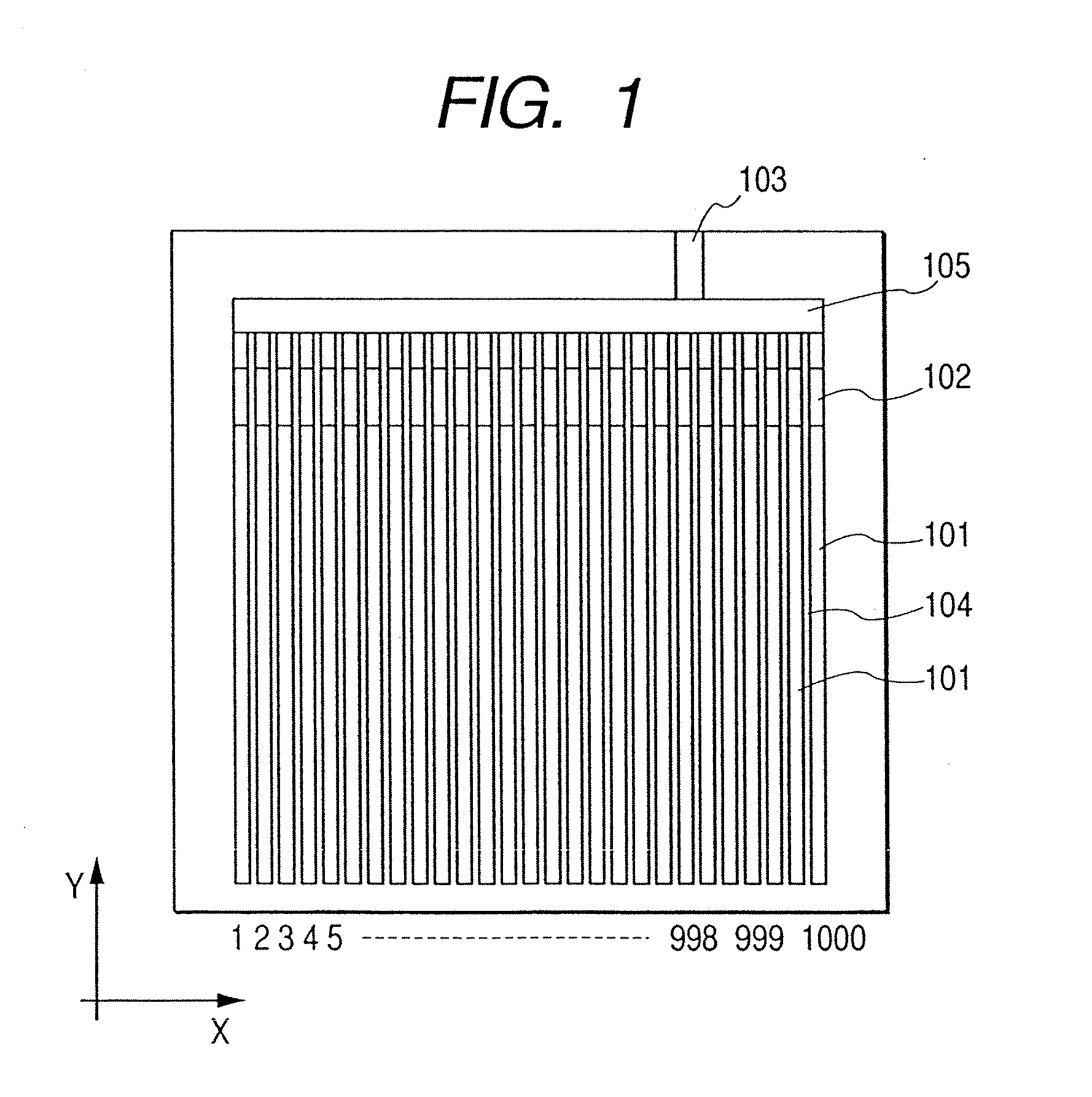Electron emission apparatus comprising electron-emitting devices, image-forming apparatus and voltage application apparatus for applying voltage between electrodes
an electron emission and electrode technology, applied in the direction of instruments, discharge tubes, luminescent screen devices, etc., can solve the problems of external resistors, inability to provide satisfactory solutions, and damage to electric discharges, so as to improve the electric connection, reduce the number of electrode segments short-circuited by the second member, and facilitate short-circuite
- Summary
- Abstract
- Description
- Claims
- Application Information
AI Technical Summary
Benefits of technology
Problems solved by technology
Method used
Image
Examples
example 1
[0164] An image-forming apparatus comprising electron-emitting devices and having a configuration as described earlier by referring to FIG. 17 was prepared. The multiple-device electron source arranged on the rear plate of the apparatus was an SCE electron source (as will be described in greater detail hereinafter) provided with a matrix wiring arrangement as shown in FIG. 3. The electron source was so designed that 1,000 devices connected by a common wire were line-sequentially driven to operate. The electron source had a total of 1,000×500 electron emitting spots. On the other hand, the face plate of the apparatus was produced by forming uniformly an ITO film on a glass substrate, which ITO film was then divided into stripe-shaped segments (101) at a pitch of 230 μm (for 1,000 lines) by photolithography and bundled together at an end thereof by way of a resistor of 100 MΩ (a patterned NiO film (102)) so that a high voltage may be applied via a terminal 103.
[0165] Then, referring ...
example 2
The Use of Divided and Isolated Metal Back Segments of Al
[0196] In this example, electroconductive black stripes (BSs) (1001) (containing carbon by 60% and water glass by 40% in a dispersed state) were formed on the glass substrate of the face plate by screen printing as shown in FIG. 15. Each of the stripes had a width of 100 μm and a thickness of 10 μm. The stripes were arranged at a pitch of 230 μm. The resistance of the stripes was 150 Ω / □.
[0197] Thereafter, stripes of RuO2 (1002) were formed as high resistance body by printing. Each of them showed a width of 100 μm, a length of 750 μm and an electric resistance of 10 MΩ. Then, R, G and B stripes were formed to fill the gaps among the BSs to a thickness of 10 μm by applying respective fluorescers P22 normally used for CRTs and baking the materials. Subsequently, a metal back of Al (1003) was formed by firstly producing an acrylic resin layer by dipping and then an Al layer to a thickness of 1,000 angstroms by evaporation and b...
example 3
The Use of Oblique Al Evaporation
[0201] In this example, after forming a resin layer by dipping as in Example 2, an Al layer was formed by means of oblique Al evaporation as shown in FIGS. 16A and 16B. In FIGS. 16A and 16B, there are shown a fluorescent body 1105, a glass substrate 1106 of the face plate and an Al film 1107 formed by evaporation.
[0202] The BSs 1101 were made to show a height of 25 μm to produce a shadow of an Al beam 1102 as shown in FIG. 16B. Isolated segment stripes of Al film 1107 were formed by causing an Al beam to obliquely strike the face plate. After baking, it was confirmed that most (more than 90%) of the devices were electrically isolated for each line by more than 100 MΩ and then the prepared face plate was hermetically bonded to a rear plate. The devices were subjected to an activation process and then tested for the resistance against electric discharges as in Example 1 to find out a remarkable improvement as compared with a specimen comprising no is...
PUM
 Login to View More
Login to View More Abstract
Description
Claims
Application Information
 Login to View More
Login to View More - R&D
- Intellectual Property
- Life Sciences
- Materials
- Tech Scout
- Unparalleled Data Quality
- Higher Quality Content
- 60% Fewer Hallucinations
Browse by: Latest US Patents, China's latest patents, Technical Efficacy Thesaurus, Application Domain, Technology Topic, Popular Technical Reports.
© 2025 PatSnap. All rights reserved.Legal|Privacy policy|Modern Slavery Act Transparency Statement|Sitemap|About US| Contact US: help@patsnap.com



